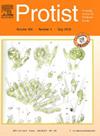NGS-based detection and differentiation of Entamoeba in Algerian wildlife and domestic animals
IF 2.1
3区 生物学
Q4 MICROBIOLOGY
引用次数: 0
Abstract
This study investigated the distribution and genetic diversity of Entamoeba in 217 faecal samples from mammals, birds, rodents, reptiles, amphibians, fish, and invertebrates sampled across Algeria. By next-generation sequencing (NGS)-based metabarcoding of SSU rDNA, an overall positivity rate of 13 % (n = 29/217) was observed, with positive cases limited to five host families: Bovidae, Camelidae, Equidae, Cervidae, and Caviidae, all of which are herbivores. From the 34 established cluster consensus sequences, we identified one species: Entamoeba bovis, two ribosomal lineages (RL1 and RL8), three conditional lineages (CL3, CL4, and CL10), and one already described sequence type, SQT-A, expanding on the known host range of previously identified Entamoeba. Also, nine novel sequences types (SQT-K to SQT-S) were proposed. Massive genetic diversity was observed, with mixed infections detected in all positive samples. Phylogenetic analyses revealed both generalist and host-specific clusters. Significant genetic similarities between the taxa identified in this study and those previously documented in hosts from Greenland were documented. We observed that herbivores are infected by multiple Entamoeba taxa, a pattern also reported in previous studies. This study highlights the power of molecular tools such as NGS and metabarcoding in deciphering complex Entamoeba co-infections, providing valuable insights into host-parasite interactions.
阿尔及利亚野生动物和家畜内阿米巴原虫的ngs检测与分化
本研究调查了阿尔及利亚全国哺乳动物、鸟类、啮齿动物、爬行动物、两栖动物、鱼类和无脊椎动物的217份粪便样本中内阿米巴原虫的分布和遗传多样性。基于下一代测序(NGS)的SSU rDNA元编码结果显示,总阳性率为13% (n = 29/217),阳性病例局限于5个寄主科:牛科、驼科、马科、鹿科和穴居动物,均为食草动物。从34个已建立的聚类一致序列中,我们确定了一个物种:牛内阿米巴,两个核糖体谱系(RL1和RL8),三个条件谱系(CL3, CL4和CL10),以及一个已经描述的序列类型SQT-A,扩展了先前鉴定的内阿米巴已知宿主范围。此外,还提出了9种新的序列类型(SQT-K ~ SQT-S)。观察到大量的遗传多样性,在所有阳性样本中检测到混合感染。系统发育分析显示了通用性和宿主特异性群集。本研究中鉴定的分类群与以前在格陵兰岛宿主中记录的分类群之间存在显著的遗传相似性。我们观察到食草动物被多个内阿米巴类群感染,这种模式在以前的研究中也有报道。这项研究强调了分子工具(如NGS和元条形码)在破译复杂的内阿米巴合并感染方面的力量,为宿主-寄生虫相互作用提供了有价值的见解。
本文章由计算机程序翻译,如有差异,请以英文原文为准。
求助全文
约1分钟内获得全文
求助全文
来源期刊

Protist
生物-微生物学
CiteScore
3.60
自引率
4.00%
发文量
43
审稿时长
18.7 weeks
期刊介绍:
Protist is the international forum for reporting substantial and novel findings in any area of research on protists. The criteria for acceptance of manuscripts are scientific excellence, significance, and interest for a broad readership. Suitable subject areas include: molecular, cell and developmental biology, biochemistry, systematics and phylogeny, and ecology of protists. Both autotrophic and heterotrophic protists as well as parasites are covered. The journal publishes original papers, short historical perspectives and includes a news and views section.
 求助内容:
求助内容: 应助结果提醒方式:
应助结果提醒方式:


